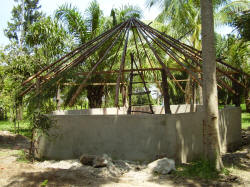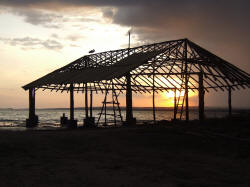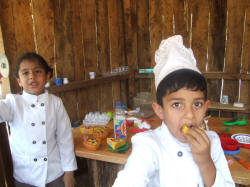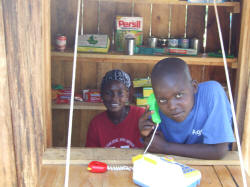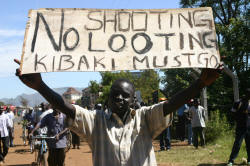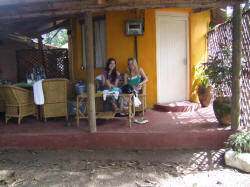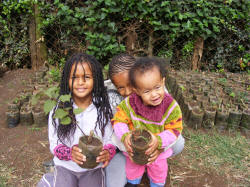|
|
History of HeshimaHow it beganIn 2004, Kenyan citizen, Stephen Ngugi and his British wife, Alison Rogers took their two children to Kenya for a holiday. Whilst in the UK, Alison and Steve had the opportunity to do lots of activities with their children: they went to farms together; took them to dance classes; went to soft play areas, museums and the theatre. They were never stuck for ideas. However when they returned to Kenya the two of them were struck by the lack of resources and places to go for families. Most of the social activities revolved around a bar and sometimes a swimming pool. Steve, a social worker, felt sad at the lack of stimulating activities for children and wanted to change things. He also felt sad that there was little opportunity for mixing! Having come from multi-cultural London, he recognized the enormous economic, tribal and religious divides that swept across Kenya and he wanted to challenge them. Furthermore, having recently finished a degree in NGO management he was acutely aware of how Kenyans often put down their own cultures and art forms in relation to art from the West. He wanted to raise the profile of the Arts within Kenya, having seen how much African Arts were valued in London. He felt sad that his own people often didn’t recognize what they had. KisumuIt was largely an accumulation of these feelings that were the seed that eventually turned into Heshima. Land eventually became available on the shores of Lake Victoria, only 8km outside Kisumu. Steve and Alison bought it and began to collect ideas from all the children’s places that they visited with their family. They shared their ideas with their friends, family and work colleagues and people started to fund raise to make Heshima a reality. Moving OutSteve gave up his work as a social worker with disabled children in London in January 2006 in order to pursue his vision of offering Kenyan children the type of opportunities he realized his own children had. Alison gave up her job as Assistant Head teacher of a secondary school in London. They sold their home to purchase the land where the centre was built and invested a great deal in buying resources. They then flew over to Kenya to the empty 8 acre plot on the shores of the lake. Building the CentreAlison worked in a school to support the family whilst Steve set about building the centre. By July 2006 students from Mayfield school joined the couple in opening the centre. This consisted of a simple children’s playground; a soft play area; a tree house; a tricycle network and paddling pool. They had built a toilet block and were running workshops in Art, Drama and Music. They started to fuse Western Art forms with African stories. Steve Siaka a local story teller started to re-tell well known tales with animal puppets. Local schools, orphanages and youth clubs started to use the centre and children started to experience things they had never tried before. At weekends, families from Kisumu and the neighbouring towns of Kakamega, Kissi, Kitale and Kericho started to come to have a picnic, play sports together and try new activities such as trampolining. Steve’s dream of creating a centre where people of all backgrounds could interact and have some fun whilst doing something creative together was starting to come true. Team Building ActivitiesAt the end of 2006, groups started to approach Heshima to see if they could offer team building activities. Steve and Alison started to put together a programme that could be used by groups who wanted to develop their team spirit. These activities are custom made and built on site. They include a range of activities that encourage delegates to question and challenge some of their beliefs and break down barriers. Steve hopes that in future these activities could help to tackle tribalism and get people to talk about the problems and bitterness more openly in an effort to deal with it. In October 2006, a volunteer from the UK came out to Heshima and built a restaurant on stilts over the lake. This was an ideal place to watch the hippos and birds and to feed the large numbers of children who visited the site. 2007After a busy Christmas period, things started to go wrong at the beginning of January 2007. There were tremendous rains and the bridge to Heshima collapsed. The level of the lake rose and the restaurant was submerged and eventually had to be dismantled. Nevertheless, support for the centre continued to grow: the girl guides from the UK joined with the Kenyan guides to provide activities and lunch for a local nursery full of orphaned children; the Red Cross held their international camp at Heshima; an organisation from the UK gave tennis lessons to all the local students at Heshima and by September Heshima offered activities for 1000 local children every week to use the centre; 100 in the morning and 100 in the afternoon. In addition, the teachers who accompanied the children were trained in interactive learning and were helped to make resources. Many were benefiting. ElectionsAfter a busy Christmas period, Heshima shut for elections. We wanted to give our staff time off to vote. Sadly, Heshima was never to open again as in the chaos that followed the ‘rigged’ elections, many centres, shops and properties were burnt to the ground. Steve is a Kikuyu and the returning president was also a Kikuyu. The elections were unfair and so people took their anger out on any Kikuyus in the area. The main opposition to the Kikuyu president was a man from the lakeside town of Kisumu, called Odinga. Sadly the violence we saw at the beginning of the New Year was only the beginning. People saw what happened in Kisumu and the violence spread to other towns and areas. Many people lost their homes, their livelihoods and many lost their lives. Kenya is still trying to recover today. Alison and Steve escaped from Kisumu on 2nd January 2008 and arrived in Nairobi. Read Alison’s post-election diary for more information. They stayed with friends all over the world for the next eight months before returning to Kisumu in August 2008. Friends and supporters encouraged them to start again. But when they returned to Kisumu it became apparent that things were still unsettled. Tension simmered below the surface threatening to erupt at the smallest provocation. They were advised not to re-fence or start again just yet. That they should wait. 2008It is very difficult to put your life on hold – especially as you don’t know how long it is going to be on hold for! And so Alison and Steve accepted work in Arusha, Tanzania. They decided to operate on a slightly different basis in Kisumu whilst things were still so tense. They now offer services at existing centres like the Shinners Centre and the Juvenile Centre. They take their art, drama and music to these centres instead of bringing children to the Heshima Centre. They need to be sure that things are completely calm and secure before investing heavily in the area again. Meanwhile, they try to challenge tribalism and discrimination through an educational programme they have put together and which they take into schools. Some of our Heshima employees run these programmes and Alison and Steve visit 3 or 4 times a year to monitor the progress, but it is difficult to keep up the momentum when living far away. Heshima in TanzaniaWhilst in Arusha they realized that the problems children face in Kenya are the same as in Arusha. Lack of opportunities for creative play and education seem to be a larger East African problem. The Maasai who live around the school found out about the centre Steve and Alison ran in Kisumu and asked that a similar one be built in their rural area. They helped Steve and Alison look for a plot and supporters raised the money in the UK. The plot has a view of Mount Meru and is near the main road, 14km out of Arusha. They bought it in Easter 2009. The plot was barren and empty like much of the surrounding area and so Steve and Alison started taking cuttings and planting them in a nursery ready for the rains. The rains didn’t come in July and so they waited to November to start planting. They drew up some plans, which have started to come to fruition. |
